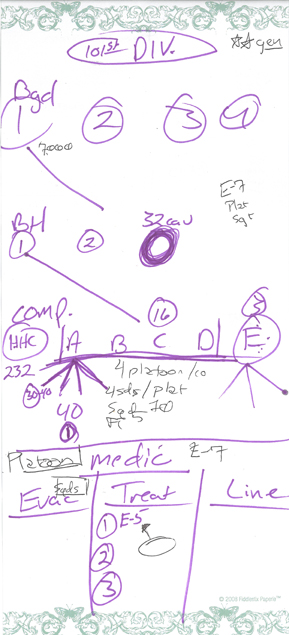I took a trip down to Clarksville, Tennessee this past weekend and spent some time with a member of the 101st Airborne. At some point, I admitted that I had no idea how the army was organised and so this member proceeded to do his best and explain to me how the army division is broken down. It was done visually by means of a chart, which I appreciate as a designer. Perhaps if I have some time, I shall attempt to translate his drawing into something more designed—fully admitting that such an outcome was not the intent of this drawing.

The purple is his explanation of a division into brigades, battalions, companies, platoons, squads, and fireteams. Beneath is the explanation of a medical platoon, with three different teams. One team is in charge of injuries on the line, or line medics. In a movie, when people scream medic after being wounded, these are the medics for which they are calling. Evac medics get the wounded from the line to a hospital-like place where they have the third group of medics, treatment medics. An E-5, or Enlisted rank of 5 (they go 1–10), is in charge of two other people or sub-groups. I forget which. But the E-5 is the most senior non-commissioned officer in the group. He has an E-7 non-commissioned officer in charge of him at the level of the platoon headquarters. I think.
The complicated lines in the middle explain how the rifle or infantry companies are organised. Two fireteams of five soldiers constitute a squad. Four squads constitute a platoon for about 40 people. And four platoons make up a rifle company for about 160 soldiers or so. The rifle battalions have a headquarters company with the scouts, medics, and mortar people. Then they have four rifle companies, Alpha, Bravo, Charlie, and Delta. Echo is a supply and maintenance company that makes sure the other companies can operate and fight. And if I recall correctly Delta Company is the heavy weapons company where they have, well, heavy weapons I guess.
At the battalion level are two infantry regiments, the 32nd cavalry regiment with all the tanks, and then if I recall there are several other support-like units at this level. But I think to save my comprehension, these were omitted from the diagram. The line connecting the 1st Battalion to the company diagram indicates that this is how each rifle or infantry battalion is generally organised.
Above the battalions are the brigades. If I recall the explanation correctly, there are the four infantry brigades, each organised like below, and then not shown are support units and the aviation brigades, which have the helicopters and aircraft. This is because the 101st specialises in deploying its infantry via rotary aircraft, which I think means helicopters. I do not believe that they jump out of airplanes.
The back of the paper explains the ranks of officers. An interesting quirk is that a major is superior to a lieutenant but that a lieutenant general is superior to a major general. The 101st is headed by a two-star general, which is, I think, a major general.
And now I know. Or at least I think I know. And knowing—or at least thinking you know—is half the battle.
